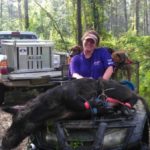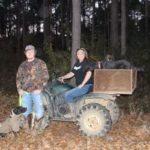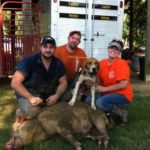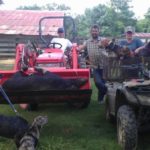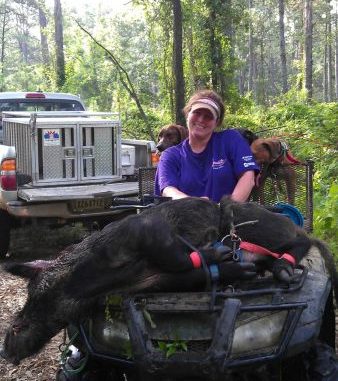
If a bunch of tobacco-chewing rednecks come to mind when you think about hog hunting, think again. This Forest Hill woman is breaking the mold and controlling the numbers of nuisance hogs in her neck of the woods.
The sun was just beginning to peek over the horizon on a clear morning. The early morning light revealed our group of hog hunters as we sat in silence on four-wheelers strung along a woods road.
Catch dogs wearing their protective vests and collars sat on the four-wheelers with us. We listened intently and watched the catch dogs for any sign that they might hear something in the distance.
We listened for cur dogs now gone for several minutes. Those same dogs had been here a little while ago, making short side trips into the woods and swinging back to us as we slowly motored along. They had found fresh scent and raced away while we stopped, killed the engines and waited.
Hannah Leigh Perkins sat astride her ATV, with blue eyes focused on the screen of a hand-held Garmin Astro 320 GPS unit.
“They’re still moving, going up the creek about 400 yards away,” she said. “The two young dogs are coming back.”
Within seconds, the pair of young hog dogs in training came loping along the road, wagging tails in greeting. Perkins looked from the screen to the pair of lanky young dogs that were equipped with Garmin tracking collars.
“I wish they could have found those hogs and bayed while the puppies were still in it. But it’ll happen,” she said with a smile.
The smile and optimism were typical of Perkins, though typical hog hunter she is not.
Quite a few women are involved in bay-pen competitions, where trained dogs bay hogs in a pen for points. And plenty of gals will shoot a hog with gun or bow from a tree stand.
But you won’t find many women in “catch and tie” hunting, where dogs bring the hog to bay, catch dogs latch on and hunters grab the back legs, roll the hog over and tie it up.
No guns, bows or knives.
Perkins is also not your average hog hunter because she does it year round. She holds a nuisance wildlife trapper license and responds to nuisance hog complaints from the plant nursery industry around her Forest Hill home. She is the “go-to girl” for many nursery owners when hogs start eating or otherwise destroying valuable inventory during the growing season.
Even during the hottest days of summer, Perkins takes advantage of early morning, late-evening or rainy-day moderate temperatures to chase hogs.
Breeding and training hog dogs go with the territory, and Perkins has made good choices in pairing sires and dams to produce pups with good potential. She then nurtures and develops that potential with patience and training to produce good, finished hog dogs.
Shortly after the young dogs returned to us, the two veteran hog dogs moved away from the creek and up a ridge as Perkins continued tracking their progress with the GPS.
They crossed the road roughly a quarter of a mile ahead of us.
The members of our hunting party included Hannah’s boyfriend Joey Rachal, his brother Jeffery, her father Mike and Benji Rhame.
Rhame is a lease member on this property, and we were here on his invitation. He knows the layout and told us there about a food plot and feeder on the ridge just off the road. We moved closer and stop once again to listen.
Hannah Perkins told us the two dogs she was tracking had moved farther along the ridge, and then down to lower ground and into the dense growth of a cutover.
“They’re circling pretty tight. I think they’re close,” she said as she continued to watch the screen.
We sat quietly listening again; this time we were rewarded as one dog barked once, then again and the other dog joined in.
Our catch dogs jumped to their feet on the four-wheelers, whining with excitement. The two young dogs that had returned to us earlier took off at top speed to rejoin the “big dogs” and get in on the bay.
The dogs then settled into a solid bay, filling the still morning air with a roar that could be heard for miles. The pups got there and joined in, raising the volume considerably.
“We better get around to them,” Mike Perkins said.
But being unfamiliar with the area, he waited for someone to offer directions for the quickest route. Hannah was still studying the GPS and told us if we returned to the main road, take a left and travel half a mile that we would be at an intersection of timber company roads very near the bayed dogs.
We fired up the engines, followed her directions and within minutes arrived at the intersection within 200 yards of the bay.
But before we could unload the catch dogs and start walking in closer, the baying suddenly stopped. We could hear brush popping as hogs and dogs scatter in the dense cover.
It’s not at all unusual for hogs to break bay and run for it, and it’s just another reason why wild feral hogs are so numerous and difficult to take — they are survivors.
Mike and I spotted a couple of hogs as they ran across the road. They seemed to have slipped out without a dog after them, so we released two fresh dogs on their trail.
We now had dogs running hogs in every direction, and Hannah Perkins had her work cut out for her on the GPS unit.
Jeffery Perkins broke out his GPS and helped monitor the races.
Before long, some of the dogs returned to us. The hogs had managed to lose their pursuers and slip away in the heavy cover. But Hannah and Jeffery told us that a couple of dogs were still on track, running in straight lines heading east and northeast.
We were still after at least two hogs. So off we went on the four-wheelers, trying to catch up.
The dog running northeast was now nearly a mile away and in a big 3- or 4-year-old cutover. Hannah and Jeffery confirmed the dog had his hog stopped and bayed.
We were on a good road, so we quickly closed in, killed the wheelers and listen. Sure enough: We heard the lone cur dog bayed low in the thicket near a gully.
Rhame knew a trail to a deer stand that would bring them close, so he and Jeffery took two catch dogs and quietly slipped in. The briars and brush were so thick that it was impossible to get a look at the hog without getting too close and risking having the hog break and run again.
The catch dogs were straining at the leashes, plenty near enough to rush in and catch. Both were sent.
They charged in, closing the short distance. Growling and brush popping accompanied the deep, guttural grunts of a big hog struggling with the dogs.
Jeffery and Rhame waded in and got the hog rolled on his side and tied.
Rhame came out of the thicket sporting a big grin.
“It’s a good bar!” he announced.
“Bar” is short for a barrow, or a castrated male. It is not unusual for boars to be caught, either in traps or by hog hunters, castrated and released. After a couple of months, castrated males lose the rank boar smell and are much more desirable for the table.
“We’ll get a four-wheeler in close and load him,” Rhame said. “Y’all better go and see about the other dog.”
Hannah still had a GPS fix on this dog. It is one of her young ones, and has been showing a lot of promise. Promise indeed, since this dog stayed hooked on the hog for a long distance and had the squealer stopped.
We took off along a narrow woods trail and followed it out to a paved road. The dog was bayed in a briar patch bordering a pasture near the road.
Once again it was too thick to see. Joey, Mike, Hannah and I sent in a single catch dog. Joey and Hannah approached from the road while Mike and I went in from the pasture side.
The Perkinses chose better than we did and got to dogs and hog quickly. Mike and I had to just about crawl through the briars.
The Perkinses had the young boar caught and were laughing at our late arrival by the time we arrived on scene. Mike and I ignored remarks about some people getting too old to be much help while we get the boar tied.
Hannah and Joey heaped praise on the young hog dog, and we dragged the boar over to the roadside and loaded him on a four-wheeler.
We loaded the dogs and start the return journey to our trucks.
The day was beginning to warm so we decided to call it a hunt. Benji had two nice hogs to pen and fatten for deer-camp barbecues and the remaining hogs were chased off, at least temporarily.
We rolled out the gate and headed for home.
At Mike Perkins’ house, we unloaded dogs while discussing the morning hunt. Hannah studied the dogs with a practiced eye. Of particular interest are the yearling half Airedale-half cur dogs. Mike crossed a hard hunting female Airedale with his best male cur and distributed the pups among Joey and Hannah, Jeffery and me.
Hannah said she believes they’ll make hog dogs and we agreed they were doing pretty well.
This is what it’s about for Hannah: Her favorite aspect of hog hunting is training and working dogs.
“It’s not about numbers for me,” she said. “I like watching young dogs learn to hunt.”
She has definite opinions and a clear preference about dog behavior and does not keep “rough” dogs — those that go in and try to catch as soon as they get the hog stopped.
Boars have razor sharp tusks and can get rough in return.
“I sell the rough dogs, and some people want them,” she said. “But I don’t’ like going to cut-up dogs.”
As a young girl, Hannah hog hunted with her grandfather, but got away from it for a while when her time became consumed with work, home and raising her four children.
But when her son, 19-year-old Ranken, expressed an interest in hog hunting a few years ago, she quickly took up the sport again. Hannah’s 20-year-old son Coi, and 16-year-old boy and girl twins — Brogue and Baylor — are enthusiastic hog hunters, too.
Hannah currently has six dogs in her pack, but like most hog hunters that number is subject to change should she run across a promising pup. That’s a likely possibility since she constantly networks with other hog hunters on Facebook, updating her page with photos and information about the latest hunt.
As February approaches and deer seasons draw to a close, hog hunters and hog dogs will be busy catching hogs all over the state.
And you can bet Hannah’s pack will be baying a big one just down the hill in that bad thicket.
